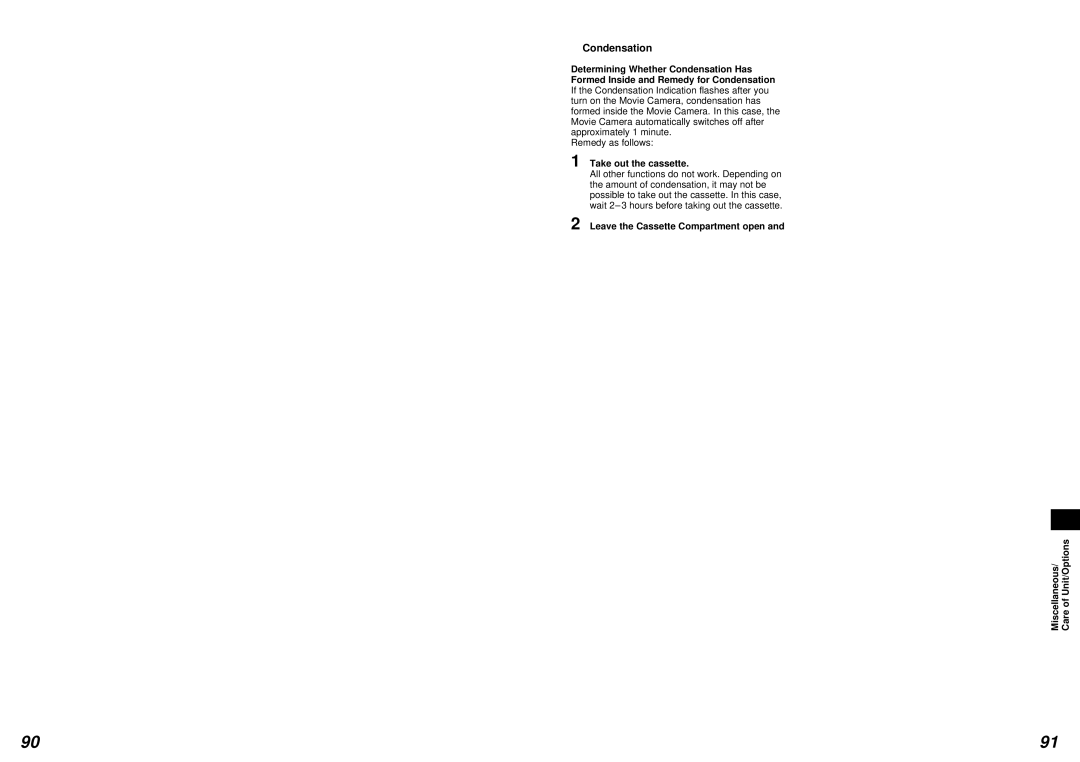Cautions for Use
Take care that no water enters the Movie Camera when using it in the rain and snow or on the beach.
³The Movie Camera and the cassette could become damaged. (It might not be repairable.)
³If seawater has accidentally splashed on the Movie Camera, moisten a soft cloth with tap water, wring it well and wipe the camera body carefully with it. Then thoroughly wipe it with a soft, dry cloth.
Keep the Movie Camera away from magnetized equipment (TVs, video games, etc.).
³If you use the Movie Camera on or near a TV, the electromagnetic radiation may cause picture and sound distortion.
³Strong magnetic fields generated by speakers and large motors may damage the recordings on the tape and distort the picture.
³The electromagnetic radiation from micro- processors can adversely influence the Movie Camera and cause picture and sound distortion.
³If the Movie Camera is adversely influenced by magnetized equipment and does not work correctly, turn the Movie Camera off, remove the Battery or disconnect the AC Adaptor and attach the Battery or connect the AC Adaptor again. Then turn the Movie Camera on.
Do not use the Movie Camera near a radio transmitter or
³If you record near a radio transmitter or high- voltage power line, the recorded picture and sound may be adversely influenced.
Do not use the Movie Camera for surveillance and other industrial application.
³If the Movie Camera is being used for a long time, the inside temperature could rise excessively and this may cause malfunction.
³This Movie Camera is not designed for industrial use.
Take care that no sand and fine dust enters the Movie Camera when using it on a beach or similar places.
³Sand and dust could damage the Movie Camera and cassette. (Be careful when inserting and removing the cassette.)
Do not spray insecticide or volatile agents on the Movie Camera.
³Such agents could deform the body and cause the surface coating to peel off.
³Do not leave the Movie Camera in direct contact with rubber or plastic products for a long time.
Do not use benzine or thinner for cleaning. ³They could deform the body and cause the
surface coating to peel off.
³Before cleaning, remove the Battery or unplug the AC Mains Lead from the AC mains socket.
³Wipe the Movie Camera with a soft, clean cloth. To remove persistent stains, wipe with a cloth moistened with mild detergent diluted with water, and then finish with a dry cloth.
³When storing or transporting the Movie Camera, place it in a softly padded bag or case to prevent the coating of the camera body from wearing off.
After use, always take out the cassette and remove the Battery or unplug the AC Mains Lead from the AC mains socket.
³If you leave the cassette in the Movie Camera, the tape can become loosened and damaged.
³If you leave the battery attached to the Movie Camera for a long time, the voltage level may drop very low so that the Battery cannot be used any more even after charging.
Notes about the AC Adaptor
³If the temperature of the Battery is extremely high or extremely low, the [CHARGE] Lamp may keep on flashing and charging is not possible. After the Battery has cooled down or warmed up sufficiently, charging starts automatically. However, if the [CHARGE] Lamp continues to flash after the Battery has cooled down or warmed up sufficiently, some malfunction may have occurred in the Battery or in the AC
ºCondensation
Determining Whether Condensation Has Formed Inside and Remedy for Condensation If the Condensation Indication flashes after you turn on the Movie Camera, condensation has formed inside the Movie Camera. In this case, the Movie Camera automatically switches off after approximately 1 minute.
Remedy as follows:
1 Take out the cassette.
All other functions do not work. Depending on the amount of condensation, it may not be possible to take out the cassette. In this case, wait 2– 3 hours before taking out the cassette.
2 Leave the Cassette Compartment open and wait for
The required time depends on the amount of condensation and the ambient temperature.
3 After
Even if the Condensation Indication is no longer displayed, wait 1 more hour for added safety before using the Movie Camera again.
Pay Attention to Condensation Even Before the Condensation Indication Appears.
³As condensation forms gradually, the Condensation Indication may not appear for the first 10– 15 minutes after condensation has formed inside.
³In an extremely cold place, the condensation could freeze and turn into frost. In such a case, it takes an additional
Remedy for a Fogged-up Lens
Set the [OFF/ON] Switch to [OFF] and leave the Movie Camera in this condition for about 1 hour. When the lens has reached about the same temperature as its surroundings, it automatically clears up.
Periodic Inspection
To ensure optimum picture quality, we recommend that you have
(However, this depends considerably on the conditions of use such as temperature, humidity and dust.)
Adaptor. In this case, consult with your dealer. ³When the battery is warm, charging takes longer
than usual.
³When you use the AC Adaptor near a radio, the radio reception may be distorted. Keep the AC Adaptor more than 1 metre away from the radio.
³When the AC Adaptor is in use, it may emit a whirring sound. However, this is normal.
³After use, be sure to disconnect the AC Mains Lead from the AC mains socket. (If you leave it connected, a small amount of electricity is consumed.)
³Always keep the terminals of the AC Adaptor and the battery clean.
Miscellaneous/ Care of Unit/Options
90 | 91 |
